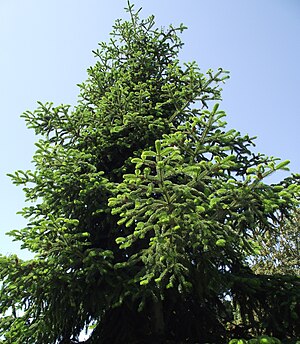Troy fir
| Troy fir | ||||||||||||
|---|---|---|---|---|---|---|---|---|---|---|---|---|

Troy fir ( Abies NORDMANNIANA subsp. Equi-Trojani ) |
||||||||||||
| Systematics | ||||||||||||
|
||||||||||||
| Scientific name | ||||||||||||
| Abies nordmanniana subsp. equi-trojani | ||||||||||||
| ( Asch. & Sint. Ex Boiss. ) Coode & Cullen |
The Troy fir ( Abies nordmanniana subsp. Equi-trojani , syn. Abies equi-trojani ), also known as Asia Minor Fir or West Turkish Fir , is a subspecies of the Nordmann fir ( Abies nordmanniana ) from the genus of firs ( Abies ) within the family of Pinaceae (Pinaceae).
description
The Troy fir grows to a height of 22 to 30 meters and a diameter of 40 to 65 centimeters at chest height . The needles are individually on the branches and are between 1.5 and 3 centimeters long. The point is blunt and may be notched in young needles. The species is monoecious-separated sex ( monoecious ). Ripe cones are brown in color and up to 13 centimeters long.
A taproot is formed which, with age, is replaced by the side roots and dies.
Distribution and location
The Troy fir is found in the Ida Mountains in the Turkish province of Çanakkale . Depending on the source, the distribution area covers an area of around 3,600 to 5,500 hectares and is divided into separate areas. It is believed that the original range was larger, but was reduced by human influence.
The Troy fir is a tree species of the sub-Mediterranean climate which is characterized above all by the absence of early and late frosts as well as precipitation in the winter half-year. It settles at altitudes between 300 and 1,650 meters and has proven to be resistant to drought and heat in summer as well as winter frost. It is a penumbra species . It is mainly granite and gneiss soils that are populated with brown earth . However, it also stagnates on crystalline lime .
Mixed stands are often formed with the sweet chestnut ( Castanea sativa ), the oriental beech ( Fagus orientalis ), the black pine ( Pinus nigra ) and various types of oak ( Quercus ). The proportion of fir trees in such mixed stands is between 30 and 50%. However, pure stands are also formed in lower elevations.
Diseases and pests
Important abiotic damaging factors are windthrow and damage caused by snow. The most important biotic damaging factor is the infestation with the fir root sponge ( Heterobasidion abietinum ), which increases the risk of windthrow. Mistletoe infestation and browsing by grazing animals, especially goats , occurs locally .
use
Due to its beautiful habit, the species is suitable as a Christmas tree .
Systematics
It is believed that the Troy fir is a naturally formed hybrid between the Nordmann fir ( Abies nordmanniana ) and the Greek fir ( Abies cephalonica ). The species is listed by some authors as a subspecies of the Nordmann fir ( Abies nordmanniana ). Genetic studies also showed that the Troy fir is more closely related to the Nordmann fir. It is believed that the species developed from a species of fir that is now extinct.
swell
literature
- Daniel Heindl: Silvicultural assessment of the tree species Abies equi-trojani in Kaz-Dagi / Western Anatolia from the point of view of possible use in Central Europe . University of Natural Resources and Life Sciences, Vienna 2000 ( abstract - diploma / master thesis).
credentials
- ↑ Entry on Germplasm Resources Information Network (GRIN)
- ↑ a b c Entry at Baumkunde.de
- ^ A b c C. Ata: Silvicultural Characteristics of Abies equi-trojani Aschers-Sinten and Growth Relationships between Pinus nigra Arnold var. Pallasiana Endl and Abies equi-trojani in Mixed Natural Forests of Turkey. In: Forestry. Vol. 62, No. 3, 1989, pp. 285-296, DOI: 10.1093 / forestry / 62.3.285 .
- ^ A b c Daniel Heindl: Silvicultural assessment of the tree species Abies equi-trojani in Kaz-Dagi / Western Anatolia from the point of view of possible use in Central Europe . University of Natural Resources and Life Sciences, Vienna 2000 ( abstract - diploma / master thesis).
- ↑ a b c Zeki Kaya, A. Skaggs, DB Neale: Genetic Differentiation of Abies equi-trojani (Asch. & Sint. Ex Boiss) Mattf. Populations from Kazdağ, Turkey and the Genetic Relationship between Turkish Firs belonging to the Abies nordmanniana Spach Complex. In: Turkish Journal of Botany. Volume 32, No. 1, 2008, pp. 1-10, PDF file .
- ↑ HT Doğmuş-Lehtijärvi, A. Lehtijärvi, K. Korhonen: Heterobasidion abietinum on Abies species in western Turkey . In: Forest Pathology . tape 36 , no. 4 , August 2006, p. 280-286 ( abstract ).
Web link
- Abies nordmanniana subsp. equi-trojani inthe IUCN Red List of Threatened Species 2013.2. Posted by: Knees, S. & Gardner, M., 2011. Retrieved November 28, 2013.